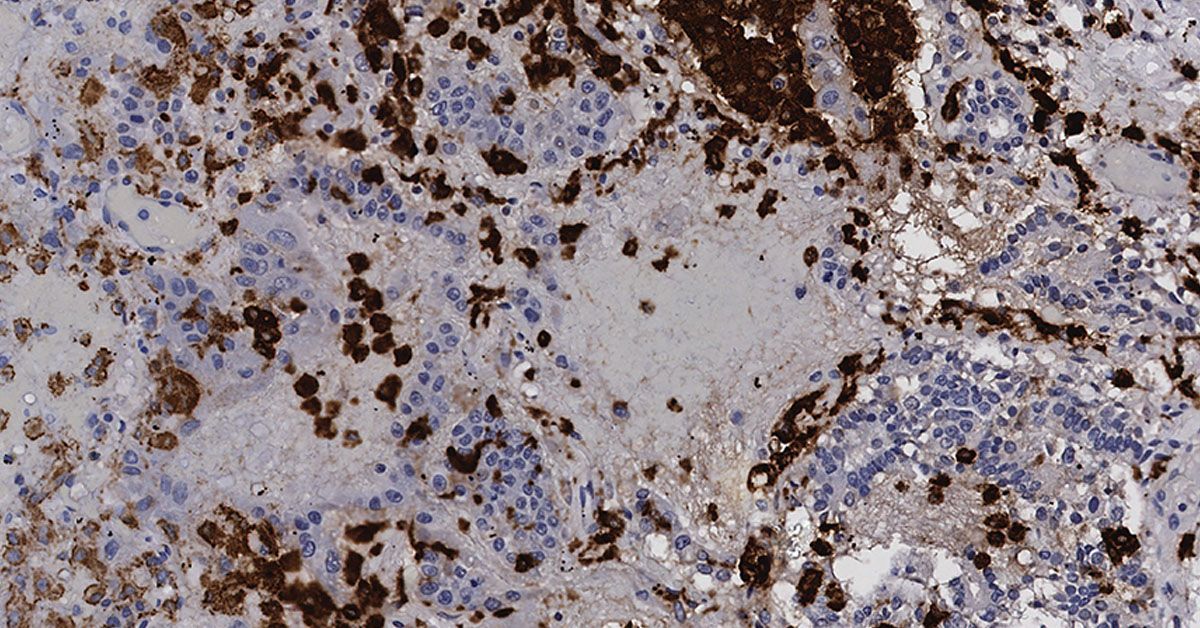The chemical structure of eganelisib, the selective PI3Kinase gamma inhibitor in clinical trials for cancer used in these studies.
Using a combination of bulk RNA sequencing and bioinformatics, the scientists analyzed tissues from humans and mice to see how SARS-CoV-2 changed the cellular and molecular makeup of infected tissues. They then treated the tissue with eganelisib to see if suppressing PI3K gamma made a difference. “We sequenced COVID-19 patient lung tissue and showed that when patients have COVID-19, a lot of their lung cells are killed and there’s a huge increase in myeloid cells. We also found the same thing in infected mice,” said Varner. “When we treated with the drug, we showed that eganelisib prevents entry of myeloid cells into tissue so they can’t do all that damage. Further studies will determine if it can actually reverse damage.” The team also had the same results in mice infected with MRSA.
No similar approach has yet been approved for clinical use. “Other drugs were tested early during the COVID-19 crisis for similar effects, with only modest success. Our work is significant because this is the first time this particular approach of targeting the myeloid cells specifically has been shown to be effective in COVID,” said Varner.
The FDA fast-tracked eganelisib for development in 2020, but it has not yet been approved by the FDA. Varner hopes that publication of this work will inspire drug manufacturers to consider making other PI3Kgamma inhibitors to treat infectious diseases like COVID-19 and MRSA. but she’s also collaborating with the infectious disease experts who worked on this paper. “We hope that this research will help us obtain funding to continue investigating this approach in other disease settings,” she said.
This study was supported by National Institutes of Health grants (R01CA226909, R01CA167426, and R01DE027325 to J.A.V. and R01CA226909 subaward to L.C.M. and R01AI176554 to V.N.); the California Office of the President Emergency COVID-19 Research Seed Funding (R00RG2398 to J.A.V.); the Cowlin Family Foundation (to S.P.P.); Fast Grants, Emergent Ventures, Mercatus Center at George Mason University (to A.J.M.); and Cancer Research Institute/Irvington postdoctoral fellowships (to J.Z. and A.G.). This work was also supported by NIH UL1TR001442 and NIH S10 OD026929 to the UCSD Center for Computational Biology & Bioinformatics Shared Resource and Genomics Center), by NIH P30CA23100 to UCSD Moores Comprehensive Cancer Center, and Department of Health and Human Services Contract HHSN272201700041I/75N93021F00002 to J.D.M.
Co-authors include: Ryan M. Shepard, Anghesom Ghebremedhin, Jingjing Hu, Roman Sasik, Kathleen M. Fisch, Hui Chen, Marc Paradise, Jason Rivera, Mohammad Amjad, Satoshi Uchiyama, Hideya Seo, Soumita Das, Farnaz Hasteh, Hana Russo, Xin Sun, Le Xu, Laura Crotty E.Alexander, Jason M. Duran, Mazen Odish, Victor Pretorius, Alejandro D. Campos, Shao-ming Chin, Tami Von Schalscha, David Cheresh, Sandip P. Patel, and Victor Nizet of the University of California San Diego; Isaraphorn Pratumchai, Jaroslav Zak, and John R. Teijaro of Scripps Research Institute; Sally R. Robinson, Denise Ann Dayao, Saul Tzipori, Cesar Piedra-Mora, and Amanda J. Martinot of Tufts University; Courtney Betts, Nell C. Kirchberger, and Lisa M. Coussens of Oregon Health & Science University; John D. Morrey of Utah State University; Rossitza Alargova, Brenda O’Connell, and Theodore A. Martinot of Infinity Pharmaceuticals.
Competing interests: R.A., B.O.’C., and T.A.M. were employees of and J.A.V. and A.J.M. were consultants for Infinity Pharmaceuticals. D.A.C. and J.A.V. are shareholders in Impact Biosciences and AlphaBeta Therapeutics. L.C.A. is a consultant for Regeneron. V.N. is a consultant for Cellics Therapeutics, I2 Pure Inc., Clarametyx BioTherapeutics, Iogen Inc., Staurus Therapeutics, and Aequor Inc. and received research funding from Micronbrane Inc. and Vaxcyte Inc. A.J.M. was a consultant for HistoWiz Inc. C.B. is currently an employee of, and holds equity in, Akoya Biosciences Inc.

